
Shkuro's Wolves
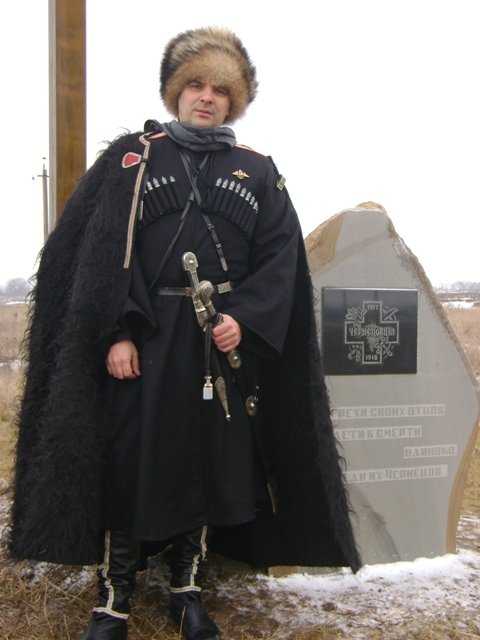 (white-guard.ru)
(white-guard.ru)
No description of Kuban troops in the Russian Civil War is complete without mentioning this famous unit.
Wolves Divizion
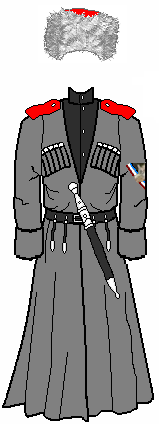 |
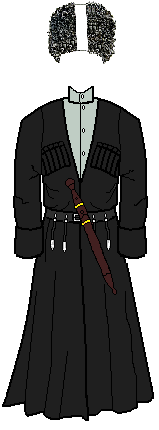 |
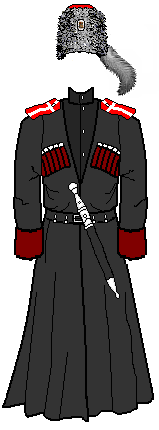 |
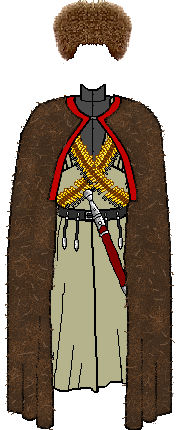 |
| Trooper: official uniform | Trooper: field dress | Vakhmistr (Sgt-Major): hat with tail | The Wolves had a tendency to a savage appearance |
The basic uniform was the standard Kuban dress, although they do seem to have favoured black clothes even more than most Kuban Cossacks.
Uniform Details
The colour of the shoulderboards was standard Kuban red, apparently with no other markings except for rank, which would be in white or silver as appropriate.
There was supposedly a badge for the sleeve showing a wolf's head over the standard Volunteer Army chevron. Photos usually do not show it.
Most illustrations of the Wolves show their fur hats with a broad white stripe down the front. This was not universal, and all the pictures we have seen of Shkuro himself show him in normal caps. Some men appear to have tied wolf's tails to their hats, dating from the WWI unit.
Allegedly many Wolves wore a papakha made of wolf-skin, and Mamontov confirms this. However plenty of photos show that this was either a late affectation or never entirely adopted.
History in the RCW
Andrei Shkuro had formed a partisan unit in the First World War, which operated behind enemy lines. With the Bolshevik Revolution he returned to this style of warfare in early 1918, initially in his native Kuban. Acting with speed, and helped by rumours that inflated his force's size, he initially fought local Soviet forces in and around Batalpashinsk and Kislovodsk.
In July 1918 he bluffed his way to capturing Stavropol', but was unable to hold it with his meagre forces. Denikin, who had just started the 2nd Kuban Campaign was forced to send troops to assist, despite already being desperately shorthanded. This was not the last time Shkuro would embarrass the people he was meant to be fighting with, but from this time he was part of the Volunteer Army commanding the "Separate Kuban Partisan Brigade". For the rest of the Kuban campaign Shkuro's men generally operated either ahead of the main White forces in partisan fashion or at least as the spearhead of any attack.
Shkuro himself was quickly promoted, so that by May 1919 he was leading the 3rd Kuban Horse Corps. His "wolves" followed him as his personal escort. The fought across the Ukraine, taking on Makhnovists as well as the Red Army.
At some stage they gained a couple of extra sotnias because by October they were the Wolves Divizion, part of the 3rd Kuban Corps (including the 1st Terek Cossack Division and 1st Caucasian Cossack Division) but now fighting with the Don Host. They numbered 538 sabres and 8 MGs, plus there was a "Supernumerary Partisan Artillery Battery" of 4 guns that may have operated with them.
In early 1920 Shkuro briefly headed the doomed Kuban Army, finishing up as a Lieutenant-General. However Baron Wrangel relieved him of all command when he took over from General Denikin, due to disagreements about discipline and Cossack separatism, and Shkuro emigrated.
Mamontov describes the Wolves as being a regiment in mid-1920, when his horse battery was attached them, but they don't appear as a regiment on the White orders of battle for that period. It seems they were still officially a divizion. Mamontov describes how initially they were on foot, but were able to capture sufficient horses to be fully mounted.
It seems they were badly mauled in the Northern Tauridia campaign, even losing their standard in October 1920 to Red cavalry. The Soviets assessed their strength just before this as 400 sabres and 20 MGs, and as still a divizion, brigaded with the Terek-Astrakhan units.
It should be noted that the wolf emblem was well chosen. Shkuro and his men were bloodthirsty, notoriously indisciplined (when not facing the enemy) and as prone to looting friends as foes.
Flags
In WWI Shkuro's partisans had a wolf's head on a black flag. (This flag was later revived in WWII.)
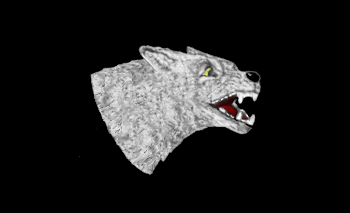
It is often alleged that in the Civil War they changed this original flag to a wolf-skin on a pole, with wolves' tails attached to the staff. Perhaps. One Russian history of Budënny talks about the banner captured in 1920 as being a wolf's head on black with "За единую и неделимую Россию" (For United and Indivisible Russia) also written on it.
There is a flag for the fourth sotnia of the unit in a Russian museum. It is swallow-tailed and small, like most sotnia flags, but more round ended than the norm:
